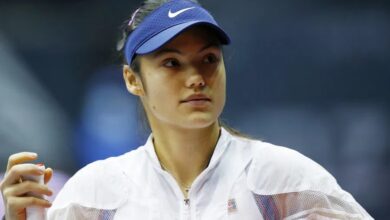Emma Raducanu: Clay surface suits my game with Olympics on horizon
Emma Raducanu believes that, in the long run, clay will turn out to be a strong surface for her. Yet it may be that this weekend’s Billie Jean King Cup tie against France has come a little too soon. Raducanu is due to take on world No 23 Caroline Garcia on Friday afternoon on an indoor clay court in Le Portel, a small town near Boulogne. She comes in with just a dozen clay-court matches on her professional CV – although she can at least point to a respectable 50 per cent winning ratio.
Garcia stands at the other end of the scale. Like so many French talents, she has built her career on the crushed brick, winning three titles and reaching the Roland Garros quarter-finals in 2017. One suspects, then, that this will be a voyage of discovery – rather than conquest – for Raducanu and her ever-improving team-mate Katie Boulter. (Remarkably, Boulter is even less familiar with the conditions, having reached the age of 27 without playing a single Tour-level match on European red clay.)
“I think, in the future, it’s going to be a surface that will actually really suit me,” said Raducanu, as the British team took questions at the 13th-Century Chateau d’Hardelot. “Maybe I’m a little bit away from that right now,” added Raducanu. “But I’m enjoying the challenge of it. And I think it’s great that we can be in this position, playing the French who are so dominant. Coming in on clay, I definitely think we’re the underdogs. But we have a lot of game, and we’re ready to play this weekend.”
Whatever happens on the match court, Raducanu’s very presence in Le Portel keeps her in the conversation for July’s Paris Olympics. The rules say that you have to represent your country twice between Olympiads in order to qualify. Yet Raducanu’s road to Paris remains a narrow one. Either she would have to storm up the rankings over the next eight weeks – a remote prospect during the European clay-court season – or she will need a wild card from the International Tennis Federation.
“It’s not really in my control,” said Raducanu, when asked about the possibility of gunning for medals at Roland Garros in July. “I mean, I know that playing this tie gives me eligibility. But it depends on so many factors, with rankings and wild-cards or whatever.”

This is the second year in a row when Anne Keothavong’s team have drawn France in this early-season qualifying round. For the 2023 tie in Coventry, Raducanu – who was then dealing with chronic wrist pain – declined to appear, so it was Boulter, ranked No 154, who faced Garcia and lost narrowly in three sets.
Twelve months on, Boulter has shot up to a career high of No 28. She faces a rematch with Garcia on Saturday afternoon, but first she will open the tie against another clay-court expert in world No49 Diane Parry. “In the past the timing hasn’t been quite right,” said Boulter, when asked about the clay conundrum and her own lack of experience in these conditions. “I had my back [injury] when it was the clay-court season. I had my foot [injury] when it was the clay-court season. I’ve tried to keep things very simple and not change surfaces too much due to the risk of injury, which in the past has been an issue with me.
“But I’ve been playing on it this past week and loving every minute,” added Boulter. “And my body feels very, very good. I’ve got no issues at all. So yeah, I think it’s a challenge. I can have a free swing and I’m really looking forward to being the underdog this weekend.” This is clearly the team position. If we’re searching for positives, home advantage favours the French so much that it could become a burden, while the visitors go in with nothing to lose. When asked whether the pressure is all on Garcia and company, Keothavong replied “Absolutely. Did anyone think anything else?”



